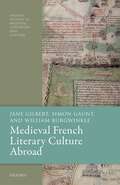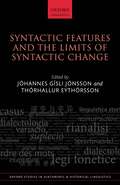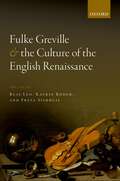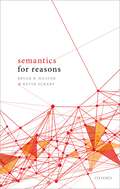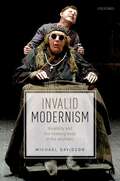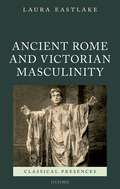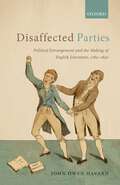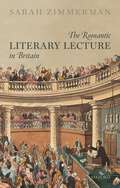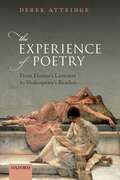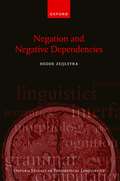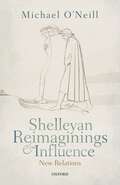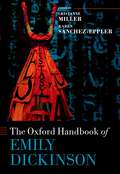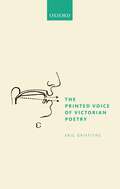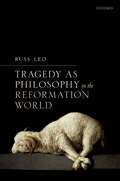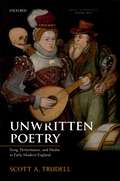- Table View
- List View
Medieval French Literary Culture Abroad (Oxford Studies in Medieval Literature and Culture)
by Jane Gilbert Simon Gaunt William BurgwinkleThe monograph series Oxford Studies in Medieval Literature and Culture showcases the plurilingual and multicultural quality of medieval literature and actively seeks to promote research that not only focuses on the array of subjects medievalists now pursue in literature, theology, and philosophy, in social, political, jurisprudential, and intellectual history, the history of art, and the history of science but also that combines these subjects productively. It offers innovative studies on topics that may include, but are not limited to, manuscript and book history; languages and literatures of the global Middle Ages; race and the post-colonial; the digital humanities, media and performance; music; medicine; the history of affect and the emotions; the literature and practices of devotion; the theory and history of gender and sexuality, ecocriticism and the environment; theories of aesthetics; medievalism. The field of medieval francophone literary culture outside France was for many years a minor and peripheral sub-field of medieval French literary studies (or, in the case of Anglo-Norman, of English studies). The past two decades, however, have seen a major reassessment of the use of French in England, in the Low Countries, in Italy, and in the eastern Mediterranean, and this impacts significantly upon the history of literature in French more generally. This book is the first to look at the question overall, rather than just at one region. It also takes a more sustained theorised approach than other studies, drawing particularly on Derrida and on Actor-Network Theory. It discusses a wide range of texts, some of which have hitherto been regarded as marginal to French literary history, and makes the case for this material being more central to the literary history of French than was allowed in more traditional approaches focused narrowly on 'France'. Many of the arguments in Medieval French Literary Culture Abroad are grounded in readings of texts in manuscript (rather than in modern critical editions), and sustained attention is paid throughout to manuscripts that were produced or travelled outside the kingdom of France.
Syntactic Features and the Limits of Syntactic Change (Oxford Studies in Diachronic and Historical Linguistics #43)
This volume brings together the latest diachronic research on syntactic features and their role in restricting syntactic change. The chapters address a central theoretical issue in diachronic syntax: whether syntactic variation can always be attributed to differences in the features of items in the lexicon, as the Borer-Chomsky conjecture proposes. In answering this question, all the chapters develop analyses of syntactic change couched within a formalist framework in which rich hierarchical structures and abstract features of various kinds play an important role. The first three parts of the volume explore the different domains of the clause, namely the C-domain, the T-domain and the ?P/VP-domain respectively, while chapters in the final part are concerned with establishing methodology in diachronic syntax and modelling linguistic correspondences. The contributors draw on extensive data from a large number of languages and dialects, including several that have received little attention in the literature on diachronic syntax, such as Romeyka, a Greek variety spoken in Turkey, and Middle Low German, previously spoken in northern Germany. Other languages are explored from a fresh theoretical perspective, including Hungarian, Icelandic, and Austronesian languages. The volume sheds light not only on specific syntactic changes from a cross-linguistic perspective but also on broader issues in language change and linguistic theory.
Fulke Greville and the Culture of the English Renaissance
by Freya Sierhuis Russ Leo Katrin RöderFulke Greville's reputation has always been overshadowed by that of his more famous friend, Philip Sidney, a legacy due in part to Greville's complex moulding of his authorial persona as Achates to Sidney's Aeneas, and in part to the formidable complexity of his poetry and prose. This volume seeks to vindicate Greville's 'obscurity' as an intrinsic feature of his poetic thinking, and as a privileged site of interpretation. The seventeen essays shed new light on Greville's poetry, philosophy, and dramatic work. They investigate his examination of monarchy and sovereignty; grace, salvation, and the nature of evil; the power of poetry and the vagaries of desire, and they offer a reconsideration of his reputation and afterlife in his own century, and beyond. The volume explores the connections between poetic form and philosophy, and argues that Greville's poetic experiments and meditations on form convey penetrating, and strikingly original contributions to poetics, political thought, and philosophy. Highlighting stylistic features of his poetic style, such as his mastery of the caesura and of the feminine ending; his love of paradox, ambiguity, and double meanings; his complex metaphoricity and dense, challenging syntax, these essays reveal how Greville's work invites us to revisit and rethink many of the orthodoxies about the culture of post-Reformation England, including the shape of political argument, and the forms and boundaries of religious belief and identity.
Semantics for Reasons
by Bryan R. Weaver Kevin ScharpSemantics for Reasons is a book about what we mean when we talk about reasons. It not only brings together the theory of reasons and natural language semantics in original ways but also sketches out a litany of implications for metaethics and the philosophy of normativity. In their account of how the language of reasons works, Bryan R. Weaver and Kevin Scharp propose and defend a view called Question Under Discussion (QUD) Reasons Contextualism. They use this view to argue for a series of novel positions on the ontology of reasons, indexical facts, the reasons-to-be- rational debate, moral reasons, and the reasons-first approach.
Semantics for Reasons
by Bryan R. Weaver Kevin ScharpSemantics for Reasons is a book about what we mean when we talk about reasons. It not only brings together the theory of reasons and natural language semantics in original ways but also sketches out a litany of implications for metaethics and the philosophy of normativity. In their account of how the language of reasons works, Bryan R. Weaver and Kevin Scharp propose and defend a view called Question Under Discussion (QUD) Reasons Contextualism. They use this view to argue for a series of novel positions on the ontology of reasons, indexical facts, the reasons-to-be- rational debate, moral reasons, and the reasons-first approach.
Invalid Modernism: Disability and the Missing Body of the Aesthetic
by Michael DavidsonInvalid Modernism contributes to an intersectional moment in disability studies by looking at modernist aesthetics through a 'defamiliar body'. It also offers an intersectional understanding of modernism by studying the representation of physical and cognitive difference during a period marked by progressive reforms in health, labor, and welfare. Readings of texts by Henry James, Samuel Beckett, Virginia Woolf, William Carlos Williams, James Joyce, Djuna Barnes, Oscar Wilde, F.T. Marinetti, Jean Toomer, an opera by Alexander Zemlinsky, and paintings and constructions by dadaists and surrealists are set against the historical developments in sexology, medical discourse, and the pseudo-sciences of eugenics and anthropometry. Modernist works are well known for challenging formal features of narration and representation, but it is seldom observed that this challenge has often been enabled by figures of shell-shocked veterans, tubercular heroines, blind soothsayers, invalid aesthetes, and neurasthenic women. Such figures complicate an aesthetics of autonomy by which modernism is often understood. Since its evolution in the eighteenth century, aesthetics has been seen in terms of judgments based on detached appreciation. What begins as a highly privative, sensate response to an object or natural formation results in a disinterested judgment about the value of that response. By looking at modernist aesthetics through a disability optic, Invalid Modernism attempts to restore the missing body to aesthetics by disclosing a structure of feeling around dramatic changes in modernity. These changes are registered on and through the bodies and minds of figures considered in medical discourse of the period as 'invalid' citizens and subjects.
Invalid Modernism: Disability and the Missing Body of the Aesthetic
by Michael DavidsonInvalid Modernism contributes to an intersectional moment in disability studies by looking at modernist aesthetics through a 'defamiliar body'. It also offers an intersectional understanding of modernism by studying the representation of physical and cognitive difference during a period marked by progressive reforms in health, labor, and welfare. Readings of texts by Henry James, Samuel Beckett, Virginia Woolf, William Carlos Williams, James Joyce, Djuna Barnes, Oscar Wilde, F.T. Marinetti, Jean Toomer, an opera by Alexander Zemlinsky, and paintings and constructions by dadaists and surrealists are set against the historical developments in sexology, medical discourse, and the pseudo-sciences of eugenics and anthropometry. Modernist works are well known for challenging formal features of narration and representation, but it is seldom observed that this challenge has often been enabled by figures of shell-shocked veterans, tubercular heroines, blind soothsayers, invalid aesthetes, and neurasthenic women. Such figures complicate an aesthetics of autonomy by which modernism is often understood. Since its evolution in the eighteenth century, aesthetics has been seen in terms of judgments based on detached appreciation. What begins as a highly privative, sensate response to an object or natural formation results in a disinterested judgment about the value of that response. By looking at modernist aesthetics through a disability optic, Invalid Modernism attempts to restore the missing body to aesthetics by disclosing a structure of feeling around dramatic changes in modernity. These changes are registered on and through the bodies and minds of figures considered in medical discourse of the period as 'invalid' citizens and subjects.
Ancient Rome and Victorian Masculinity (Classical Presences)
by Laura EastlakeAncient Rome and Victorian Masculinity examines Victorian receptions of ancient Rome, with a specific focus on how those receptions were deployed to create useable models of masculinity. Romans in Victorian literature are at once pagan persecutors, pious statesmen, pleasure-seeking decadents, and heroes of empire, and these manifold and often contradictory representations are used as vehicles equally to capture the martial virtue of Wellington and to condemn the deviance and degeneracy of Oscar Wilde. In the works of Thomas Macaulay, Wilkie Collins, Anthony Trollope, H. Rider Haggard, and Rudyard Kipling, among others, Rome emerges as a contested space with an array of possible scripts and signifiers which can be used to frame masculine ideals, or to vilify perceived deviance from those ideals, though with a value and significance often very different to ancient Greek models. Sitting at the intersection of reception studies, gender studies, and interdisciplinary literary and cultural studies across discourses ranging from education and politics, this volume offers the first comprehensive examination of the importance of ancient Rome as a cultural touchstone for nineteenth-century manliness and Victorian codifications of masculinity.
Ancient Rome and Victorian Masculinity (Classical Presences)
by Laura EastlakeAncient Rome and Victorian Masculinity examines Victorian receptions of ancient Rome, with a specific focus on how those receptions were deployed to create useable models of masculinity. Romans in Victorian literature are at once pagan persecutors, pious statesmen, pleasure-seeking decadents, and heroes of empire, and these manifold and often contradictory representations are used as vehicles equally to capture the martial virtue of Wellington and to condemn the deviance and degeneracy of Oscar Wilde. In the works of Thomas Macaulay, Wilkie Collins, Anthony Trollope, H. Rider Haggard, and Rudyard Kipling, among others, Rome emerges as a contested space with an array of possible scripts and signifiers which can be used to frame masculine ideals, or to vilify perceived deviance from those ideals, though with a value and significance often very different to ancient Greek models. Sitting at the intersection of reception studies, gender studies, and interdisciplinary literary and cultural studies across discourses ranging from education and politics, this volume offers the first comprehensive examination of the importance of ancient Rome as a cultural touchstone for nineteenth-century manliness and Victorian codifications of masculinity.
Disaffected Parties: Political Estrangement and the Making of English Literature, 1760-1830
by John Owen HavardDisaffected Parties reveals how alienation from politics effected crucial changes to the shape and status of literary form. Recovering the earliest expressions of grumbling, irritability, and cynicism towards politics, this study asks how unsettled partisan legacies converged with more recent discontents to forge a seminal period in the making of English literature, and thereby poses wide-ranging questions about the lines between politics and aesthetics. Reading works including Laurence Sterne's Tristram Shandy, James Boswell's Life of Johnson, the novels of Maria Edgeworth and Jane Austen, and the satirical poetry of Lord Byron in tandem with print culture and partisan activity, this book shows how these writings remained animated by disaffected impulses and recalcitrant energies at odds with available party positions and emerging governmental norms—even as they sought to imagine perspectives that looked beyond the divided political world altogether. 'No one can be more sick of-or indifferent to politics than I am' Lord Byron wrote in 1820. Between the later eighteenth century and the Romantic age, disaffected political attitudes acquired increasingly familiar shapes. Yet this was also a period of ferment in which unrest associated with the global age of revolutions (including a dynamic transatlantic opposition movement) collided with often inchoate assemblages of parties and constituencies. As writers adopted increasingly emphatic removes from the political arena and cultivated familiar stances of cynicism, detachment, and retreat, their estrangement also promised to loop back into political engagement-and to make their works 'parties' all their own.
Disaffected Parties: Political Estrangement and the Making of English Literature, 1760-1830
by John Owen HavardDisaffected Parties reveals how alienation from politics effected crucial changes to the shape and status of literary form. Recovering the earliest expressions of grumbling, irritability, and cynicism towards politics, this study asks how unsettled partisan legacies converged with more recent discontents to forge a seminal period in the making of English literature, and thereby poses wide-ranging questions about the lines between politics and aesthetics. Reading works including Laurence Sterne's Tristram Shandy, James Boswell's Life of Johnson, the novels of Maria Edgeworth and Jane Austen, and the satirical poetry of Lord Byron in tandem with print culture and partisan activity, this book shows how these writings remained animated by disaffected impulses and recalcitrant energies at odds with available party positions and emerging governmental norms—even as they sought to imagine perspectives that looked beyond the divided political world altogether. 'No one can be more sick of-or indifferent to politics than I am' Lord Byron wrote in 1820. Between the later eighteenth century and the Romantic age, disaffected political attitudes acquired increasingly familiar shapes. Yet this was also a period of ferment in which unrest associated with the global age of revolutions (including a dynamic transatlantic opposition movement) collided with often inchoate assemblages of parties and constituencies. As writers adopted increasingly emphatic removes from the political arena and cultivated familiar stances of cynicism, detachment, and retreat, their estrangement also promised to loop back into political engagement-and to make their works 'parties' all their own.
The Romantic Literary Lecture in Britain
by Sarah ZimmermanAt the beginning of the nineteenth century, the literary lecture arrived on London's cultural scene as an influential critical medium and popular social event. It flourished for two decades in the hands of the period's most prominent lecturers: Samuel Taylor Coleridge, John Thelwall, Thomas Campbell, and William Hazlitt. Lecturers aimed to shape auditors' reading habits, burnish their own professional profiles, and establish a literary canon. Auditors wielded their own considerable influence, since their sustained approbation was necessary to a lecturer's success, and independent series could collapse midway if attendance waned. Two chapters are therefore devoted to the auditors, whose creative responses to what they heard often constituted cultural works in their own right. Auditors wrote poems and letters about lecture performances, acted as patrons to lecturers, and hosted dinners and conversation parties that followed these events. Prominent auditors included John Keats, Mary Russell Mitford, Henry Crabb Robinson, Catherine Maria Fanshawe, and Lady Charlotte Bury. The Romantic public literary lecture is a fascinating cultural phenomenon in its own right, but understanding the medium has significant implications for some of the period's most important literary criticism, such as Coleridge's readings of Shakespeare and Hazlitt's Lectures on the English Poets (1818). The book's two main aims are to chart the emergence of the literary lecture as a popular medium and to develop a critical approach to these events by drawing on an interdisciplinary discussion about how to treat historical speaking performances.
The Romantic Literary Lecture in Britain
by Sarah ZimmermanAt the beginning of the nineteenth century, the literary lecture arrived on London's cultural scene as an influential critical medium and popular social event. It flourished for two decades in the hands of the period's most prominent lecturers: Samuel Taylor Coleridge, John Thelwall, Thomas Campbell, and William Hazlitt. Lecturers aimed to shape auditors' reading habits, burnish their own professional profiles, and establish a literary canon. Auditors wielded their own considerable influence, since their sustained approbation was necessary to a lecturer's success, and independent series could collapse midway if attendance waned. Two chapters are therefore devoted to the auditors, whose creative responses to what they heard often constituted cultural works in their own right. Auditors wrote poems and letters about lecture performances, acted as patrons to lecturers, and hosted dinners and conversation parties that followed these events. Prominent auditors included John Keats, Mary Russell Mitford, Henry Crabb Robinson, Catherine Maria Fanshawe, and Lady Charlotte Bury. The Romantic public literary lecture is a fascinating cultural phenomenon in its own right, but understanding the medium has significant implications for some of the period's most important literary criticism, such as Coleridge's readings of Shakespeare and Hazlitt's Lectures on the English Poets (1818). The book's two main aims are to chart the emergence of the literary lecture as a popular medium and to develop a critical approach to these events by drawing on an interdisciplinary discussion about how to treat historical speaking performances.
The Experience of Poetry: From Homer's Listeners to Shakespeare's Readers
by Derek AttridgeWas the experience of poetry—or a cultural practice we now call poetry—continuously available across the two-and-a-half millennia from the composition of the Homeric epics to the publication of Ben Jonson's Works and the death of Shakespeare in 1616? How did the pleasure afforded by the crafting of language into memorable and moving rhythmic forms play a part in the lives of hearers and readers in Ancient Greece and Rome, Europe during Late Antiquity and the Middle Ages, and Britain during the Renaissance? In tackling these questions, this book first examines the evidence for the performance of the Iliad and the Odyssey and of Ancient Greek lyric poetry, the impact of the invention of writing on Alexandrian verse, the performances of poetry that characterized Ancient Rome, and the private and public venues for poetic experience in Late Antiquity. It moves on to deal with medieval verse, exploring the oral traditions that spread across Europe in the vernacular languages, the place of manuscript transmission, the shift from roll to codex and from papyrus to parchment, and the changing audiences for poetry. A final part investigates the experience of poetry in the English Renaissance, from the manuscript verse of Henry VIII's court to the anthologies and collections of the late Elizabethan era. Among the topics considered in this part are the importance of the printed page, the continuing significance of manuscript circulation, the performance of poetry in pageants and progresses, and the appearance of poets on the Elizabethan stage. In tracking both continuity and change across these many centuries, the book throws fresh light on the role and importance of poetry in western culture.
The Experience of Poetry: From Homer's Listeners to Shakespeare's Readers
by Derek AttridgeWas the experience of poetry—or a cultural practice we now call poetry—continuously available across the two-and-a-half millennia from the composition of the Homeric epics to the publication of Ben Jonson's Works and the death of Shakespeare in 1616? How did the pleasure afforded by the crafting of language into memorable and moving rhythmic forms play a part in the lives of hearers and readers in Ancient Greece and Rome, Europe during Late Antiquity and the Middle Ages, and Britain during the Renaissance? In tackling these questions, this book first examines the evidence for the performance of the Iliad and the Odyssey and of Ancient Greek lyric poetry, the impact of the invention of writing on Alexandrian verse, the performances of poetry that characterized Ancient Rome, and the private and public venues for poetic experience in Late Antiquity. It moves on to deal with medieval verse, exploring the oral traditions that spread across Europe in the vernacular languages, the place of manuscript transmission, the shift from roll to codex and from papyrus to parchment, and the changing audiences for poetry. A final part investigates the experience of poetry in the English Renaissance, from the manuscript verse of Henry VIII's court to the anthologies and collections of the late Elizabethan era. Among the topics considered in this part are the importance of the printed page, the continuing significance of manuscript circulation, the performance of poetry in pageants and progresses, and the appearance of poets on the Elizabethan stage. In tracking both continuity and change across these many centuries, the book throws fresh light on the role and importance of poetry in western culture.
Negation and Negative Dependencies (Oxford Studies in Theoretical Linguistics #80)
by Hedde ZeijlstraThis book presents a novel overarching account of negation and negative dependencies, based on novel data from language variation, language acquisition, and language change. Negation is a universal property of natural language, but languages can significantly differ in how they express it: there is variation in the form and position of negative elements, the number of manifestations of negative morphemes, and in the restrictions on the use of Negative and Positive Polarity Items. In this volume, Hedde Zeijlstra explores the hypothesis that all known syntactic, semantic, pragmatic, and lexical ways of encoding dependencies should be also be attested in the domain of negation, unless they are independently ruled out. He shows that the pluriform landscape of negative dependencies and markers of negation that emerges has broader implications for theories of syntax and semantics and their interface.
Shelleyan Reimaginings and Influence: New Relations
by Michael O'NeillThrough attuned close readings, this volume brings out the imaginative and formal brilliance of Percy Bysshe Shelley's writing as it explores his involvement in processes of dialogue and influence. Shelley recognizes that poetic individuality is the reward of connectedness with other writers and cultural influences. 'A great Poem is a fountain forever overflowing with the waters of wisdom and delight', he writes, 'and after one person and one age has exhausted all its divine effluence which their peculiar relations enable them to share, another and yet another succeeds, and new relations are ever developed, the source of an unforeseen and an unconceived delight' (A Defence of Poetry). He is among the major Romantic poetic exponents and theorists of influence, because of his passionately intelligent commitment to the onward dissemination of ideas and feelings, and to the unpredictable ways in which poets position themselves and are culturally positioned between past and future. The book has a tripartite structure. The first three chapters seek to illuminate his response to representative texts, figures, and themes that constitute the triple pillars of his cultural inheritance: the classical world (Plato); Renaissance poetry (Spenser and Milton); Christianity and, in particular, the concept of deity and the Bible. The second and major section of the book explores Shelley's relations and affinities with, as well as differences from, his immediate predecessors and contemporaries: Hazlitt and Lamb; Wordsworth; Coleridge; Southey; Byron; Keats (including the influence of Dante on Shelley's elegy for his fellow Romantic) and the great painter J. M. W. Turner, with whom he is often linked. The third section considers Shelley's reception by later nineteenth-century writers, figures influenced by and responding to Shelley including Beddoes, Hemans, Landon, Tennyson, and Swinburne. A coda discusses the body of critical work on Shelley produced by A. C. Bradley, a figure who stands at the threshold of twentieth-century thinking about Shelley.
Shelleyan Reimaginings and Influence: New Relations
by Michael O'NeillThrough attuned close readings, this volume brings out the imaginative and formal brilliance of Percy Bysshe Shelley's writing as it explores his involvement in processes of dialogue and influence. Shelley recognizes that poetic individuality is the reward of connectedness with other writers and cultural influences. 'A great Poem is a fountain forever overflowing with the waters of wisdom and delight', he writes, 'and after one person and one age has exhausted all its divine effluence which their peculiar relations enable them to share, another and yet another succeeds, and new relations are ever developed, the source of an unforeseen and an unconceived delight' (A Defence of Poetry). He is among the major Romantic poetic exponents and theorists of influence, because of his passionately intelligent commitment to the onward dissemination of ideas and feelings, and to the unpredictable ways in which poets position themselves and are culturally positioned between past and future. The book has a tripartite structure. The first three chapters seek to illuminate his response to representative texts, figures, and themes that constitute the triple pillars of his cultural inheritance: the classical world (Plato); Renaissance poetry (Spenser and Milton); Christianity and, in particular, the concept of deity and the Bible. The second and major section of the book explores Shelley's relations and affinities with, as well as differences from, his immediate predecessors and contemporaries: Hazlitt and Lamb; Wordsworth; Coleridge; Southey; Byron; Keats (including the influence of Dante on Shelley's elegy for his fellow Romantic) and the great painter J. M. W. Turner, with whom he is often linked. The third section considers Shelley's reception by later nineteenth-century writers, figures influenced by and responding to Shelley including Beddoes, Hemans, Landon, Tennyson, and Swinburne. A coda discusses the body of critical work on Shelley produced by A. C. Bradley, a figure who stands at the threshold of twentieth-century thinking about Shelley.
The Oxford Handbook of Emily Dickinson (Oxford Handbooks)
The Oxford Handbook of Emily Dickinson is designed to engage, inform, interest, and delight students and scholars of Emily Dickinson, of nineteenth-century US literature and cultural studies, of American poetry, and of the lyric. It also establishes potential agendas for future work in the field of Dickinson studies. This is the first collection on Dickinson to foreground the material and social culture of her time while opening new windows to interpretive possibility in ours. The volume strives to balance Dickinson's own center of gravity in the material culture and historical context of nineteenth-century Amherst with the significance of important critical conversations of our present, thus understanding her poetry with the broadest "Latitude of Home"—as she puts it in her poem "Forever-is composed of Nows." Debates about the lyric, about Dickinson's manuscripts and practices of composition, about the viability of translation across language, media, and culture, and about the politics of class, gender, place, and race circulate through this volume. These debates matter to our moment but also to our understanding of hers. Although rooted in the evolving history of Dickinson criticism, the chapters foreground truly new original research and a wide range of innovative critical methodologies, including artistic responses to her poetry by musicians, visual artists, and other poets. The suppleness and daring of Dickinson's thought and uses of language remain open to new possibilities and meanings, even while they are grounded in contexts from over 150 years ago, and this collection expresses and celebrates the breadth of her accomplishments and relevance.
The Oxford Handbook of Emily Dickinson (Oxford Handbooks)
by Cristanne Miller, Karen Sánchez-epplerThe Oxford Handbook of Emily Dickinson is designed to engage, inform, interest, and delight students and scholars of Emily Dickinson, of nineteenth-century US literature and cultural studies, of American poetry, and of the lyric. It also establishes potential agendas for future work in the field of Dickinson studies. This is the first collection on Dickinson to foreground the material and social culture of her time while opening new windows to interpretive possibility in ours. The volume strives to balance Dickinson's own center of gravity in the material culture and historical context of nineteenth-century Amherst with the significance of important critical conversations of our present, thus understanding her poetry with the broadest "Latitude of Home"—as she puts it in her poem "Forever-is composed of Nows." Debates about the lyric, about Dickinson's manuscripts and practices of composition, about the viability of translation across language, media, and culture, and about the politics of class, gender, place, and race circulate through this volume. These debates matter to our moment but also to our understanding of hers. Although rooted in the evolving history of Dickinson criticism, the chapters foreground truly new original research and a wide range of innovative critical methodologies, including artistic responses to her poetry by musicians, visual artists, and other poets. The suppleness and daring of Dickinson's thought and uses of language remain open to new possibilities and meanings, even while they are grounded in contexts from over 150 years ago, and this collection expresses and celebrates the breadth of her accomplishments and relevance.
The Printed Voice of Victorian Poetry
by Eric GriffithsThe Printed Voice of Victorian Poetry starts from a simple fact: our written language does not represent the way we speak. Intonation, accent, tempo, and pitch of utterance can be inferred from a written text but they are not clearly demonstrated there. The book shows the implications of this fact for linguists and philosophers of language and offers fundamental criticisms of some recent work in these fields. It aims principally to describe the ways in which nineteenth-century English poets–Tennyson, Browning, Hopkins–responded creatively to the ambiguities involved in writing down their own voices, the melodies of their speech. Original readings of the poets' work are given, both at a minutely detailed level and with regard to major preoccupations of the period–immortality, morbidity, marriage, social divisions, and religious conversions–and in this way Eric Griffiths offers a new map of Victorian poetry.
The Printed Voice of Victorian Poetry
by Eric GriffithsThe Printed Voice of Victorian Poetry starts from a simple fact: our written language does not represent the way we speak. Intonation, accent, tempo, and pitch of utterance can be inferred from a written text but they are not clearly demonstrated there. The book shows the implications of this fact for linguists and philosophers of language and offers fundamental criticisms of some recent work in these fields. It aims principally to describe the ways in which nineteenth-century English poets–Tennyson, Browning, Hopkins–responded creatively to the ambiguities involved in writing down their own voices, the melodies of their speech. Original readings of the poets' work are given, both at a minutely detailed level and with regard to major preoccupations of the period–immortality, morbidity, marriage, social divisions, and religious conversions–and in this way Eric Griffiths offers a new map of Victorian poetry.
Tragedy as Philosophy in the Reformation World
by Russ LeoTragedy as Philosophy in the Reformation World examines how sixteenth- and seventeenth-century poets, theologians, and humanist critics turned to tragedy to understand providence and agencies human and divine in the crucible of the Reformation. Rejecting familiar assumptions about tragedy, vital figures like Philipp Melanchthon, David Pareus, Lodovico Castelvetro, John Rainolds, and Daniel Heinsius developed distinctly philosophical ideas of tragedy, irreducible to drama or performance, inextricable from rhetoric, dialectic, and metaphysics. In its proximity to philosophy, tragedy afforded careful readers crucial insight into causality, probability, necessity, and the terms of human affect and action. With these resources at hand, poets and critics produced a series of daring and influential theses on tragedy between the 1550s and the 1630s, all directly related to pressing Reformation debates concerning providence, predestination, faith, and devotional practice. Under the influence of Aristotle's Poetics, they presented tragedy as an exacting forensic tool, enabling attentive readers to apprehend totality. And while some poets employed tragedy to render sacred history palpable with new energy and urgency, others marshalled a precise philosophical notion of tragedy directly against spectacle and stage-playing, endorsing anti-theatrical theses on tragedy inflected by the antique Poetics. In other words, this work illustrates the degree to which some of the influential poets and critics in the period, emphasized philosophical precision at the expense of—even to the exclusion of—dramatic presentation. In turn, the work also explores the impact of scholarly debates on more familiar works of vernacular tragedy, illustrating how William Shakespeare's Hamlet and John Milton's 1671 poems take shape in conversation with philosophical and philological investigations of tragedy. Tragedy as Philosophy in the Reformation World demonstrates how Reformation took shape in poetic as well as theological and political terms while simultaneously exposing the importance of tragedy to the history of philosophy.
Tragedy as Philosophy in the Reformation World
by Russ LeoTragedy as Philosophy in the Reformation World examines how sixteenth- and seventeenth-century poets, theologians, and humanist critics turned to tragedy to understand providence and agencies human and divine in the crucible of the Reformation. Rejecting familiar assumptions about tragedy, vital figures like Philipp Melanchthon, David Pareus, Lodovico Castelvetro, John Rainolds, and Daniel Heinsius developed distinctly philosophical ideas of tragedy, irreducible to drama or performance, inextricable from rhetoric, dialectic, and metaphysics. In its proximity to philosophy, tragedy afforded careful readers crucial insight into causality, probability, necessity, and the terms of human affect and action. With these resources at hand, poets and critics produced a series of daring and influential theses on tragedy between the 1550s and the 1630s, all directly related to pressing Reformation debates concerning providence, predestination, faith, and devotional practice. Under the influence of Aristotle's Poetics, they presented tragedy as an exacting forensic tool, enabling attentive readers to apprehend totality. And while some poets employed tragedy to render sacred history palpable with new energy and urgency, others marshalled a precise philosophical notion of tragedy directly against spectacle and stage-playing, endorsing anti-theatrical theses on tragedy inflected by the antique Poetics. In other words, this work illustrates the degree to which some of the influential poets and critics in the period, emphasized philosophical precision at the expense of—even to the exclusion of—dramatic presentation. In turn, the work also explores the impact of scholarly debates on more familiar works of vernacular tragedy, illustrating how William Shakespeare's Hamlet and John Milton's 1671 poems take shape in conversation with philosophical and philological investigations of tragedy. Tragedy as Philosophy in the Reformation World demonstrates how Reformation took shape in poetic as well as theological and political terms while simultaneously exposing the importance of tragedy to the history of philosophy.
Unwritten Poetry: Song, Performance, and Media in Early Modern England
by Scott A. TrudellVocal music was at the heart of English Renaissance poetry and drama. Virtuosic actor-singers redefined the theatrical culture of William Shakespeare and his peers. Composers including William Byrd and Henry Lawes shaped the transmission of Renaissance lyric verse. Poets from Philip Sidney to John Milton were fascinated by the disorienting influx of musical performance into their works. Musical performance was a driving force behind the period's theatrical and poetic movements, yet its importance to literary history has long been ignored or effaced. This book reveals the impact of vocalists and composers upon the poetic culture of early modern England by studying the media through which—and by whom—its songs were made. In a literary field that was never confined to writing, media were not limited to material texts. Scott Trudell argues that the media of Renaissance poetry can be conceived as any node of transmission from singer's larynx to actor's body. Through his study of song, Trudell outlines a new approach to Renaissance poetry and drama that is grounded not simply in performance history or book history but in a more synthetic media history.
